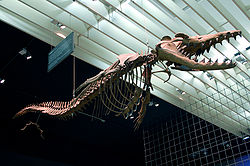- Dorudon
-
Dorudon
Temporal range: Late Eocene
Dorudon atrox, Senckenberg Museum Scientific classification Kingdom: Animalia Phylum: Chordata Class: Mammalia Order: Cetacea Suborder: Archaeoceti Family: Basilosauridae Subfamily: Dorudontinae
Miller, 1923Genus: Dorudon
Gibbes, 1845Species - Dorudon atrox
- Dorudon serratus
Dorudon ("Spear-Tooth") was a genus of ancient cetacean that lived alongside Basilosaurus 41 to 33 million years ago, in the Eocene. They were about five meters (16 ft) long and were most likely carnivorous, feeding on small fish and mollusks. Dorudontines lived in warm seas around the world. Fossils have been found in North America, Egypt as well as Pakistan the eastern part of which bordered the ancient Tethys Sea.
Contents
Description
 Dorudon pelvis, an example of a vestigial organ, from a specimen at the Smithsonian Natural History Museum, Washington, DC
Dorudon pelvis, an example of a vestigial organ, from a specimen at the Smithsonian Natural History Museum, Washington, DC D. atrox, closeup of head, Canadian Museum of Nature
D. atrox, closeup of head, Canadian Museum of Nature
Dorudontines were originally believed to be juvenile individuals of Basilosaurus as their fossils are similar but smaller. They have since been shown to be a different genus with the discovery of Dorudon juveniles. Although they look very much like modern whales, basilosaurines and dorudontines lacked the 'melon organ' that allows their descendants to use ultrasound as effectively as modern whales. Like other basilosaurids, their nostrils were midway from the snout to the top of the head. The Dorudon calves may have fallen prey to hungry Basilosaurus, as shown by unhealed bite marks on the skulls of some juvenile Dorudon.
In popular culture
Dorudon was featured in the episode Whale Killer in the BBC's documentary Walking with Beasts, as well as in the second part of its follow-up, Sea Monsters. They are depicted as living in groups, with their calves being the primary prey of their relative, Basilosaurus.
See also
References
- Haines, Tim & Chambers, Paul. (2006) The Complete Guide to Prehistoric Life. Canada: Firefly Books Ltd.
External links
Categories:- Early whales
- Eocene mammals
- Eocene extinctions
Wikimedia Foundation. 2010.


